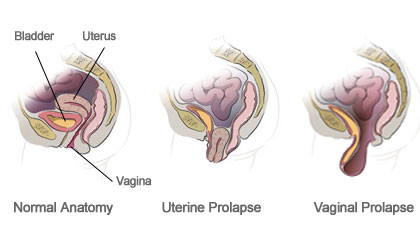Robotic Assisted Sacrocolpopexy of Uterine and Vaginal Prolapse
 Prolapse is the falling of an organ on the pelvic floor (vagina, uterus, bladder, or rectum) when the connective tissues or muscles in the body cavity can’t hold the pelvis in its natural position. There are many causes of prolapse, including aging, childbirth, weight gain, and strenuous physical labor.
Prolapse is the falling of an organ on the pelvic floor (vagina, uterus, bladder, or rectum) when the connective tissues or muscles in the body cavity can’t hold the pelvis in its natural position. There are many causes of prolapse, including aging, childbirth, weight gain, and strenuous physical labor.
Treatment for Uterine or Vaginal Prolapse
Sacrocolpopexy is the surgical correction of uterine or vaginal vault prolapse. In sacrocolpopexy, mesh is used to hold the vagina in the correct anatomical position, anchoring the vagina to the sacrum. This procedure can also be performed following a hysterectomy to treat uterine prolapse, which provides long-term support of the vagina. Traditionally, this is an open surgery, where a 15- to 30-centimeter horizontal incision is made in the lower abdomen to provide access for the abdominal organs, including the uterus.
Robotic-Assisted Surgery: A Less Invasive Option
When performed robotically with the da Vinci Surgical System, sacrocolpopexy uses precise instruments that create only small incisions in your abdomen. Robotic-assisted sacrocolpopexy has many advantages over traditional open surgery, including:
- Significantly less pain
- Less blood loss and need for transfusions
- Less risk of infection
- Less scarring
- Shorter hospital stay
- Shorter recovery time
- Quicker return to normal activities
As with any surgery, these benefits cannot be guaranteed since surgery is patient- and procedure-specific. While robotic-assisted sacrocolpopexy is considered safe and effective, it may not be appropriate for every individual. Always ask your doctor about all treatment options, as well as their risks and benefits.